AAP stands for Angkor Archaeological Park
Since it's only a half day tour starting from 2PM, our trip for today will be for Angkor Thom & Phnom Bakheng.
It sounded as if we only go to 2 places, but Angkor Thom is a really large area, as it is used to be the capital city of the Khmer empire so there are lots of temples inside Angkor Thom itself. As for Phnom Bakheng our guide didn't recommend this place for us to see the sunset as at our month of visit there is usually no sunset and Phnom Bakheng is really crowded for sunset time, but since we insisted on it as I really wanted to ride the elephant to go up the temple as my first elephant ride ever, he was flexible to our wishes. He also recommended elephant ride at Bayon as it is also available there, but I wanted the one at Phnom Bakheng as the elephant track is hill and the one at Bayon is just on a plain level ground, I am very happy I took the one at Phnom Bakheng.
At the entrance of AAP, we will have to pass a gate to buy ticket to visit the temples. There are 3 types of tickets available : 1 day pass cost USD 20.00, 3 days pass for USD 40 and 7 days pass USD 60. We bought a 3 day pass for us, we don't have to use it in 3 days in a row, it can be used 3 days in 1 week, as for the 7 days pass can be use for 7 days in a month. If you buy the pass at 5 PM to watch sunset, it will be counted starting from the next day. They will take a picture of you to be printed on the ticket so that it can't be used for another person. Please put your ticket in a safe and accessible place since they regularly check the pass at most of the temple entrance, we just gave it to our guide to make it easier. As for the Cambodian, they don't need to buy tickets since it's free for them to enter, so you don't need to buy tickets for your driver and guide.
At the entrance of AAP, we will have to pass a gate to buy ticket to visit the temples. There are 3 types of tickets available : 1 day pass cost USD 20.00, 3 days pass for USD 40 and 7 days pass USD 60. We bought a 3 day pass for us, we don't have to use it in 3 days in a row, it can be used 3 days in 1 week, as for the 7 days pass can be use for 7 days in a month. If you buy the pass at 5 PM to watch sunset, it will be counted starting from the next day. They will take a picture of you to be printed on the ticket so that it can't be used for another person. Please put your ticket in a safe and accessible place since they regularly check the pass at most of the temple entrance, we just gave it to our guide to make it easier. As for the Cambodian, they don't need to buy tickets since it's free for them to enter, so you don't need to buy tickets for your driver and guide.
Angkor Thom
 |
| Southern Gate |
 |
| Moat Southern gate - Churning of the sea of milk |
Our first stop was the entry gate of Angkor Thom, there are 5 entry gate, we were to entry from the Southern Gate which is the most beautiful gate since before the gate we were greeted by statues of the Gods (devas) and the asura (foe of the devas) who were holding a naga portraying the "churning of the sea of milk" myth. Some of the heads are not the original ones anymore, so they replaced them to make us able to picture how it would look like in the olden days.
The gate itself is like the ones in Bayon, of which on top of the tower has 4 faces, facing 4 different directions, and on the below are elephant heads.
 |
| Front road of Bayon - Bayon from the front |
 |
| 1st level of Bayon |
This beautiful temple was built by king Jayavarman VII, he was a Budhist, so Bayon is a Budhist temple. The 4 faces on the top towers facing 4 different directions are said to be the faces of the bodhisattva, but some also says that it picture the face of the king Jayavarman VII. It is said that there are 216 stone faces carved in this temple, which means it has 54 towers.
 |
| 4 faced statue of Bayon as if having a conversation |
 |
| The face with the widest smile |
The carvings are magnificent on such scale, that each faces resembles each other but some has it's unique such as the widest smile etc and sometimes if we see it from a viewpoint we can see as if the statues are having a conversation with each other.
It is said that Bayon was built in a hurry due to the war at the time, since it is using smaller stones so that the condition right now is not as good as Angkor Wat and some of the carving are not finished.
Since it is said that king Jayavarman VII builds a lot of hospitals in his days, nowadays there is a children hospital in Siem Reap that is named Jayavarman, to honor him.
There are just a lot of spots you want to take pictures, thankfully our guide really knows the best spots and the best thing I like is he gave us some time to explore the temple on our own to take pictures as we like.
Terrace of the Elephants & Prasat Suor Prat
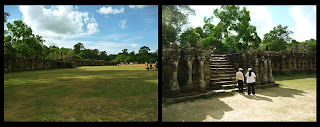 |
| Terrace of Elephants - elephants wall |
 |
| Terrace of the Elephant - garuda wall - Prasar Suor Prat in front |
Terrace of the elephants is a 2-3 meters stone wall with carving of elephants on the left side of the main stairs to go on top of the wall and alternate of garuda and lion headed figures on right side. Once on top we can see that the wall itself is quite wide around 3-5 meters, with the view of the Prasat Suor Prat (12 towers), it was said that a rope was hooked on top of the towers to connect each other and performers to do acrobats, and performers show their skills on the plain or games are held while the king watches from the top of the main stairs and the royal family plus the important people of the empire would watch behind him, it is also said that back in the days there were wooden roof to protect the spectators from the sun.
But there is another theory for Prasat Suor Prat use, it is said that it is used to settle legal disputes and matters of criminal justice. Parties in disputes were kept in the towers for a few days. The one to emerge in ill health was declared the loser.
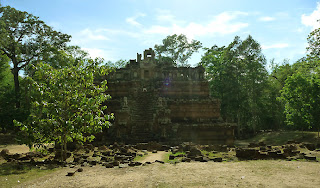 |
| Phimeneakas |
Going down the main stairs from the other side we enter a gate to go into the royal palace area. There were no palace anymore since at at the time houses including the palace are made of wood, so there is nothing left of it just plains with trees inside. Finally we reached Phimeanakas, we didn't get on top of the temple since the stairs are really steep so we just passed it after taking some pictures.
I especially asked our guide to pass this site since there is an interesting myth behind it, that intrigues me to see it. It is said that the temple was inhibited by a naga which would transform to a woman, the king of Angkor was suppose to make love with the serpent every night to avoid disaster on the kingdom.
Exiting the royal palace area, we came upon 2 ponds, which was said the small one is for the male (king) and the big one is for the female (king's wives), another theory was said that the ponds were for aquatic sport for the king to watch.
Terrace of the Leper King
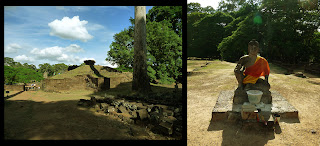 |
| hill assumed for cremation - statue thought as the leper king |
Why is it call the Terrace of the Leper King? At the time the site was found, there was a statue on top of a mound which has lost it's hand but not in a way that it's been cut off so people misunderstood it to connect the statue with a legend which says that there was one king of Angkor was a leper. But afterwards, another theory says that on top of the mound was supposed to held the cremation of the king. The statue itself is not the original statue, it is a replica, as the original one is placed in the National Museum in Phnom Penh.
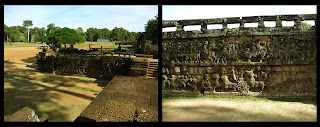 |
| Carved walls at terrace of the leper king |
In front of the mound there are 2 walls layers which is beautifully full carved with nagas, demons and other mythological beings, if I remember it right it's about the afterlife. Too bad we didn't spend enough time to see the relief in details as we have to reach Phnom Bakheng for the elephant ride to reach the temple not too late to avoid long queue.
Phnom Bakheng & elephant ride
 |
| elephant ride with Tijo the damray - tip pocket on the back of the rider |
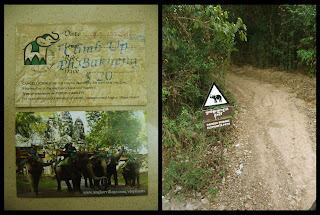 |
| elephant ride ticket - elephant path |
At first we were planing for me to ride the elephant and hubby to walk on foot so that he could take pictures. But after knowing the track for elephants and human are different we decided for both of us to take the elephant ride, and that was a smart decision to make. If I was alone, I didn't know if I can enjoy it or not, out of fear as it was my first time ever elephant ride and the track is very narrow for an elephant with ravine on the side and the track is used for up and down track, so sometimes we will have to share the track with another elephant.
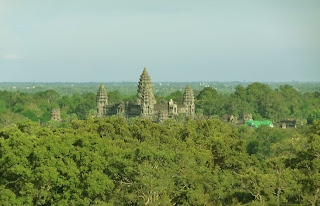 |
| Angkor Wat - view from Phnom Bakheng hill |
At a point nearby the temple, our elephant rider would make a stop so that we can enjoy a view of Angkor Wat from afar, it really made me want to go there even more. It cost USD 20 per person for going up the hill as Phnom Bakheng is located on top of a hill and USD 15 for going down. Talking with the elephant rider, we came to know that elephant in local language is damray and our elephant's name is Tijo, so after the ride is over on top of the hill we said "Hokun Tijo the damray :)" as hokun is thank you in Khmer language (hopefully I spelled it correctly).
Turns out it was not a long queue to go up the temple, probably many people already knew that at this month of visit there is usually no sunset. On top of the temple there is a small chamber in the center and a pile of stone with lingga nearby it ( above pictures) .
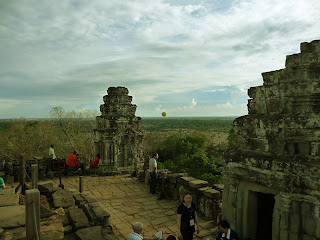 |
| Phnom Bakheng view with balloon ride at the background |
 |
| sunset at Phnom Bakheng |
While waiting for the sunset (facing west) our view will be the west Baray. Sunset itself was around 6 PM and as expected by our tour guide there is not much of a sunset to see. It took around 10-15 minutes to get down the hill to go back to our tuk-tuk with his ice box filled with delicious cold water bottle :)



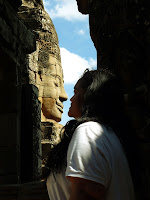

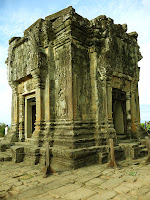
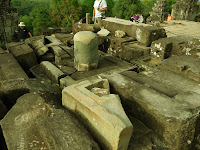




No comments:
Post a Comment